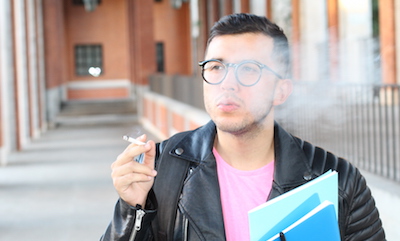Coming Out as Bisexual Associated with Increased Risk of Smoking.

For many years, lesbian, gay, bisexual, and other non-heterosexual (LGB+) folks have been known to be more likely to smoke than their straight counterparts.
But a new, first-of-its-kind School of Public Health study paints a more precise picture by looking at LGB+ identities separately and over time, finding that bisexuality is the identity most associated with smoking, especially around the time of coming out.
Published in the journal JAMA Pediatrics, the nationally-representative cohort study followed 7,843 youth and young adults over three years, finding that those who came out as bisexual were twice as likely as consistently-heterosexual participants to start smoking. Coming out as lesbian, gay, or another non-heterosexual identity, or having a consistent LG+ identity, was not associated with being more likely to smoke.
The study “highlights the importance of moving beyond static measures of sexual identity towards more dynamic measures that capture critical periods of vulnerability,” says Andrew Stokes, assistant professor of global health and the study’s corresponding author.
“This approach turned out to be really important, because it revealed disparities that would have otherwise been missed if we measured identity at one time point, or grouped all LGB+ identities together,” says study lead author Alyssa Harlow, a doctoral candidate in the Department of Epidemiology.
“Bisexual young people may face unique forms of discrimination and stigma that increase their risk for smoking or other substance use behaviors,” she says. “For example, they may experience stigma from heterosexual individuals as well as from within the LGB+ community. There’s also prior research that shows that bisexual populations have worse mental health outcomes than LG+ populations.
‘The findings point to a need for public health interventions specifically designed to address the unique needs, experiences, and stressors associated with coming out and identifying as bisexual,” Harlow says.
For the study, the researchers used data from the first four waves of the nationwide Population Assessment of Tobacco and Health (PATH) study, which surveyed the same 14-29–year-olds three times between 2013 and 2018. (There were too few transgender respondents in this sample for the researchers to include gender identity in their analysis.) The researchers adjusted for other variables including sex, age, race/ethnicity, education level (for participants over 18) and parents’ education level (for participants under 18), and where participants lived (urban/nonurban, and region of the US).
By the third wave, 14 percent of the respondents had smoked at some point, and 6 percent were current smokers. The researchers found that the same sexual identity patterns held true both for having smoked at any point in the study period and for being a current smoker.
Compared with a consistent heterosexual identity, coming out as LGB+ or moving from one LGB+ identity to another was associated with being nearly twice as likely to smoke during the study period.
But when the researchers looked at LGB+ identities separately, they found that, compared to a consistent heterosexual identity, coming out as bisexual was associated with being more than twice as likely to smoke. Participants with LG+ identities in the first wave who shifted to a bisexual identity, or vice versa, were twice as likely to smoke.
On the other hand, participants with a consistent LG+ identity throughout the three waves of the study and participants who started out identifying as heterosexual and came out as LG+ were not more likely to smoke than those with a consistent heterosexual identity—while those with a consistent bisexual identity were slightly more likely to smoke.
The researchers say that the study’s unique approach to LGB+ identities—separated and over time—could provide valuable insights for other issues that disproportionately affect the community, including mental health issues and substance use.
But to make that possible, more national surveys need to ask youth about their sexual orientation and gender identity, says study co-author Dielle Lundberg (SPH’19), a research fellow in the Department of Global Health.
“The PATH study is unique because it asks youth about their sexual orientation and gender identity. Most national surveys do not,” Lundberg says.
“We must advocate for better data. Whenever national surveys fail to ask about sexual orientation and gender identity, they are directly contributing to health inequities for LGBTQ+ populations.”
The study’s other co-authors are: Julia Raifman, assistant professor of health law, policy & management; Carl Streed, assistant professor of medicine at the School of Medicine; Emelia Benjamin, professor of epidemiology at SPH and of cardiovascular medicine at the School of Medicine; and Andy S.L. Tan of the University of Pennsylvania.
—Michelle Samuels